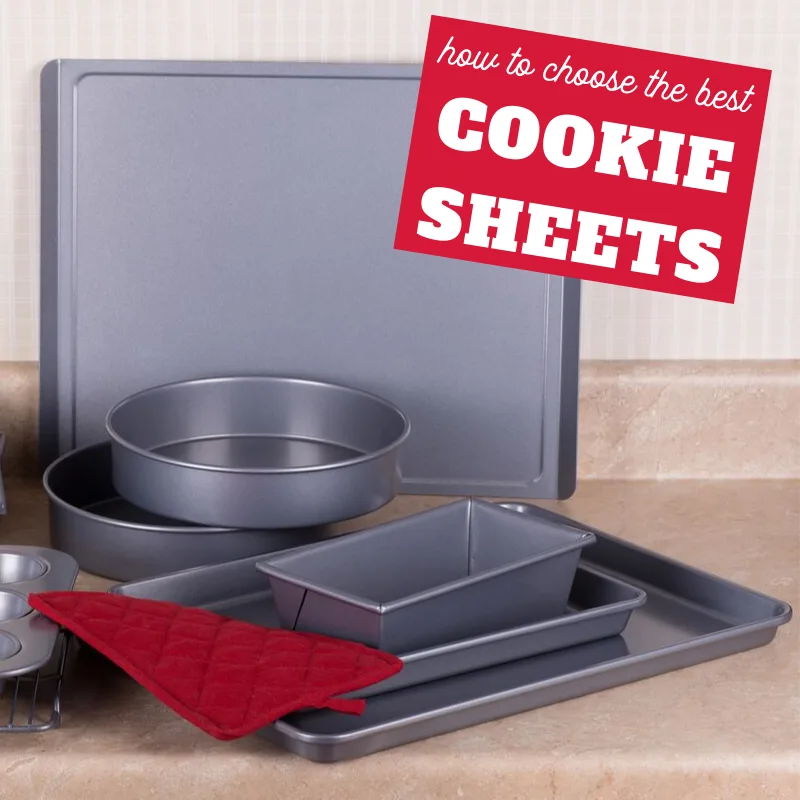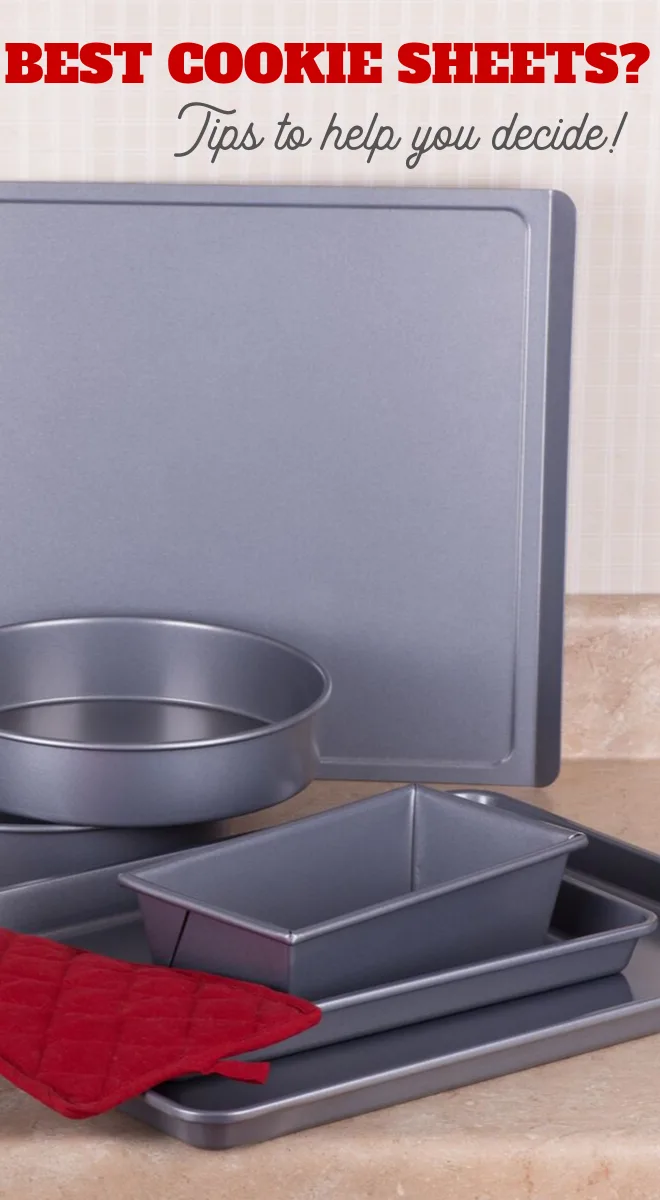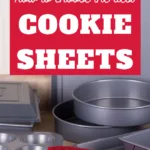If you like to bake, you first need to know how to choose the best cookie sheet. Because it’s not all it’s cracked up to be. To be able to cook the best yummy cookie recipes, you need to know what to use!
And while it may be easiest to just grab the first baking sheet you see, it may not be the best idea.
Sometimes, even when a baker follows a cookie recipe the results may not be what she hoped. In some cases, the individual may not be giving proper attention to the baking process.

In other cases, the material a cookie sheet is made from may create specific results.
Basically, the cookie sheet you choose to bake with is the foundation for baking the best cookies. But, even if you don’t have the best tools on hand, a good baker can bake great cookies just by knowing a few tricks and understanding the way the baking sheet will deflect the heat.
Keep reading to learn how to choose the best cookie sheet and also how to bake with one even if it’s not the best baking sheet in the world.
How to Shop for a Baking Sheet:
Shopping for a Baking Sheet First, know the size of your oven. The best sheets are two inches shorter and narrower than the oven interior. This allows heat to circulate around the pan.
Choose the heaviest gauge metal baking sheets, often called heavy duty. Lightweight sheets can warp or cause uneven baking. Also, when you’re removing your baking sheet from the oven, if you have hot cookie and wobbly baking sheet, you run the risk of the cookies sliding together or even all the way off. I’ve found it’s best to just have a heavy duty cookie sheet on hand.
You don’t necessarily need a rimmed baking sheet, as the sides may deflect heat from cookies during baking. Avoid sides that are an inch or more tall, these are jellyroll pans and are better suited to things like cinnamon rolls.
A baker who has difficulty getting his or her cookies to brown can try flipping the pan and baking on the bottom of the pan. Just be sure to cover it with parchment paper or wax paper, if you choose to do this, because you don’t want whatever weird stuff might be on the bottom of your pan on the bottom of your cookies.
I like using aluminum half sheet pans for smaller batches and only breaking out my larger baking pans when I’m baking a lot of cookies.

Types of Cookie Sheets:
A trip to the bakeware aisle will show that selecting a cookie sheet might not be as easy as it sounds. The different materials can change the way cookies bake. For the baker who has a set of cookie sheets, know how they bake and then adjust baking time or temperature.
Insulated cookie sheets are made from two sheets of aluminum separated by a layer of insulating air. Cookies can take longer to bake and may not brown on the bottom, making it difficult to know when the cookies are baked. I also had one insulated cookie sheet that warped after just a few uses. I don’t know if the metal on either side of the insulated gap were just weaker than a normal baking sheet aluminized steel, but I do know that I didn’t use that baking sheet any more.
Non-stick baking sheets have nonstick coatings that makes the cookies easy to remove. However, the dark finish may cause cookies to brown too much. Look for the manufacturer’s suggestions about lowering the oven temperature on nonstick surface baking sheets, or choose one with a light colored finish. A nonstick cookie sheet can also be easy to clean, but can also be easily scratched.
Dark aluminum baking sheets have an almost black finish which conducts heat and speeds up baking time but may cause the bottom of the cookies to brown too much. Which can also be a problem with roasting vegetables on a dark cookie sheet as the high heat can burn the bottoms of the veggies before the insides cook.
Shiny aluminum or stainless steel cookie sheets can be made from hardened aluminum alloy, anodized aluminum, tinplate steel, stainless steel or silicon-coated aluminum. These pans create even browning of cookies. I prefer these for baking cookies, honestly, but I do occasionally have trouble with the cookies sticking. So, sometimes I use these shiny baking sheets and then cover it with a piece of parchment paper or wax paper. This keeps the cookie from sticking to the pan, but I get the nice, even heat that’s necessary for a nicely browned cookie.

Hacks to Bake Perfect Cookies:
While the type of cookie sheet is important, how a baker uses that cookie sheet may be even more important. Even with a really sad an unfortunate cookie sheet, a good baker that knows a few tricks to bake perfect cookies can really wow the taste testers.
Here are my favorite hacks to bake the perfect cookie:
- Preheat the oven and make certain that it is the correct temperature before putting a sheet of cookie dough into the oven. If you put them in too early, they run the risk of over-cooking or not cooking evenly.
- If the cookies brown unevenly, rotate the cookie sheet from front-to-back or left-to-right halfway through the baking. This may not be a problem with your cookie sheet, but rather with your oven not heating evenly. I have a friend who swears she’s got a “cold spot” in her oven!
- Grease a cookie sheet only if a recipe calls for it. Otherwise, the fat can cause the cookies to spread too much and brown too quickly on the edges. And, if it calls for greasing the cookie sheet, be sure to do so lightly as too much grease can do the same thing–basically like frying the cookie while it’s baking.
- Lining cookie sheets with a silicone baking mat or baking parchment eliminates the need to grease the pan and makes clean-up easy. Parchment paper is my favorite as there’s zero clean-up. But silicone baking mats are a super handy tool and I end up using them even when parchment paper is available sometimes because there’s just a lot less fuss and I can take the silicone mat off the baking sheet and reuse the baking sheet without fear of the cookies sliding around–because the mat is pretty sturdy.
- Ideally, bake only one sheet of cookies at a time.
- Place that baking sheet in the middle of the rack in the middle of the oven.
- If you have to bake more than one sheet of cookies at a time then place one above the other on separate oven racks and rotate the sheets to a different rack halfway through the baking process.
- Use two or even three cookie sheets. One is in the oven, one is cooling, and one is being prepared with the next batch of dough.
Choosing the correct cookie sheet, or learning how to adapt use of a baking sheet, can help a baker turn out batches of perfect cookies. Learning the best way to bake cookies on baking sheets also maximizes the quality of these sweet treats.
My favorite Cookie Sheet Resources:
The following items are affiliate links on Amazon because they may be a bit hard to find in your normal store. I wanted you to be able to see exactly which things we are using.
Best Baking Pan Cookie Recipes:
Once you have a great cookie sheet in hand, you’re definitely going to want a great cookie recipe to get started making awesome baked goods. Check out these yummy cookie recipes I gathered here:






